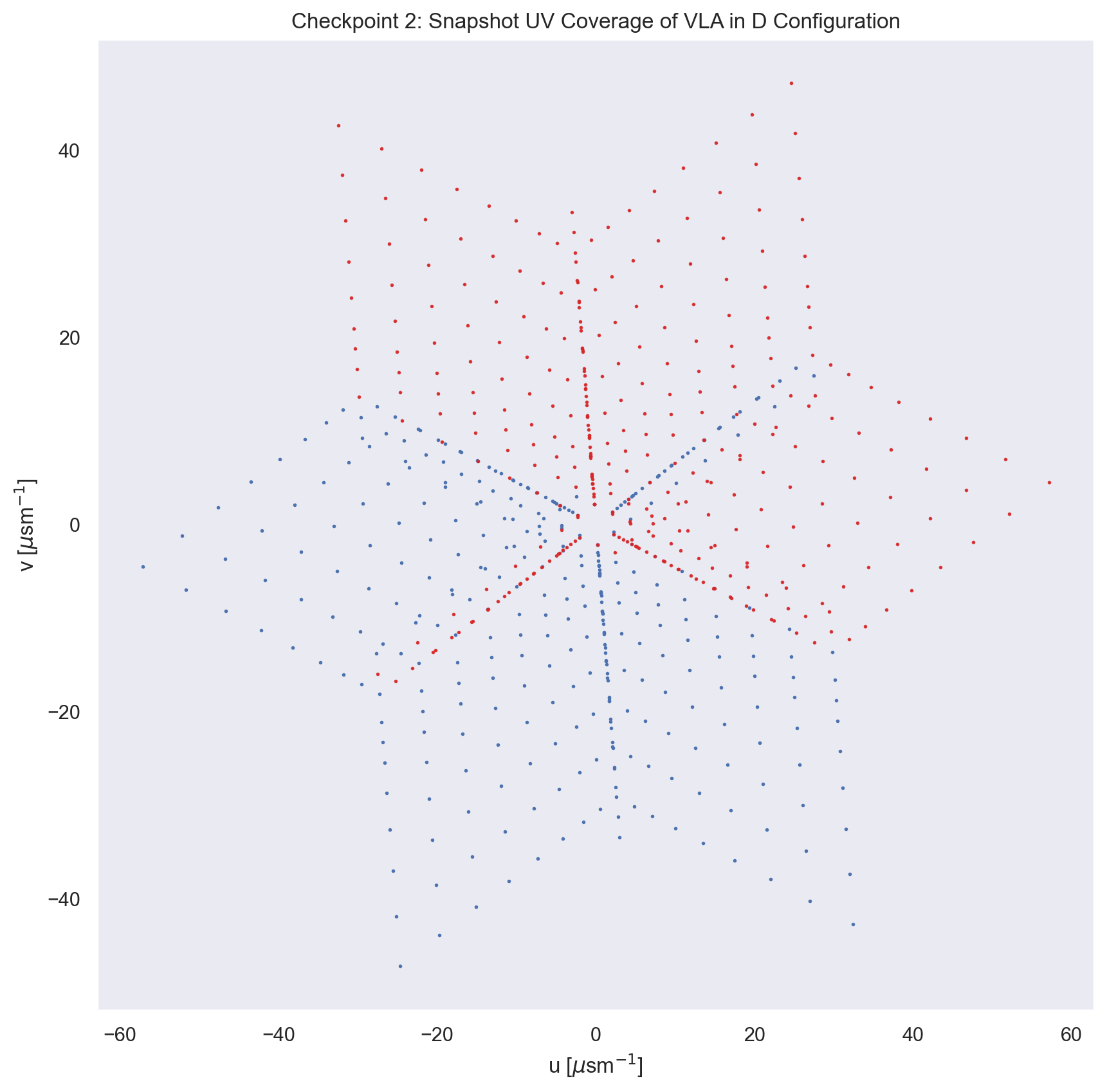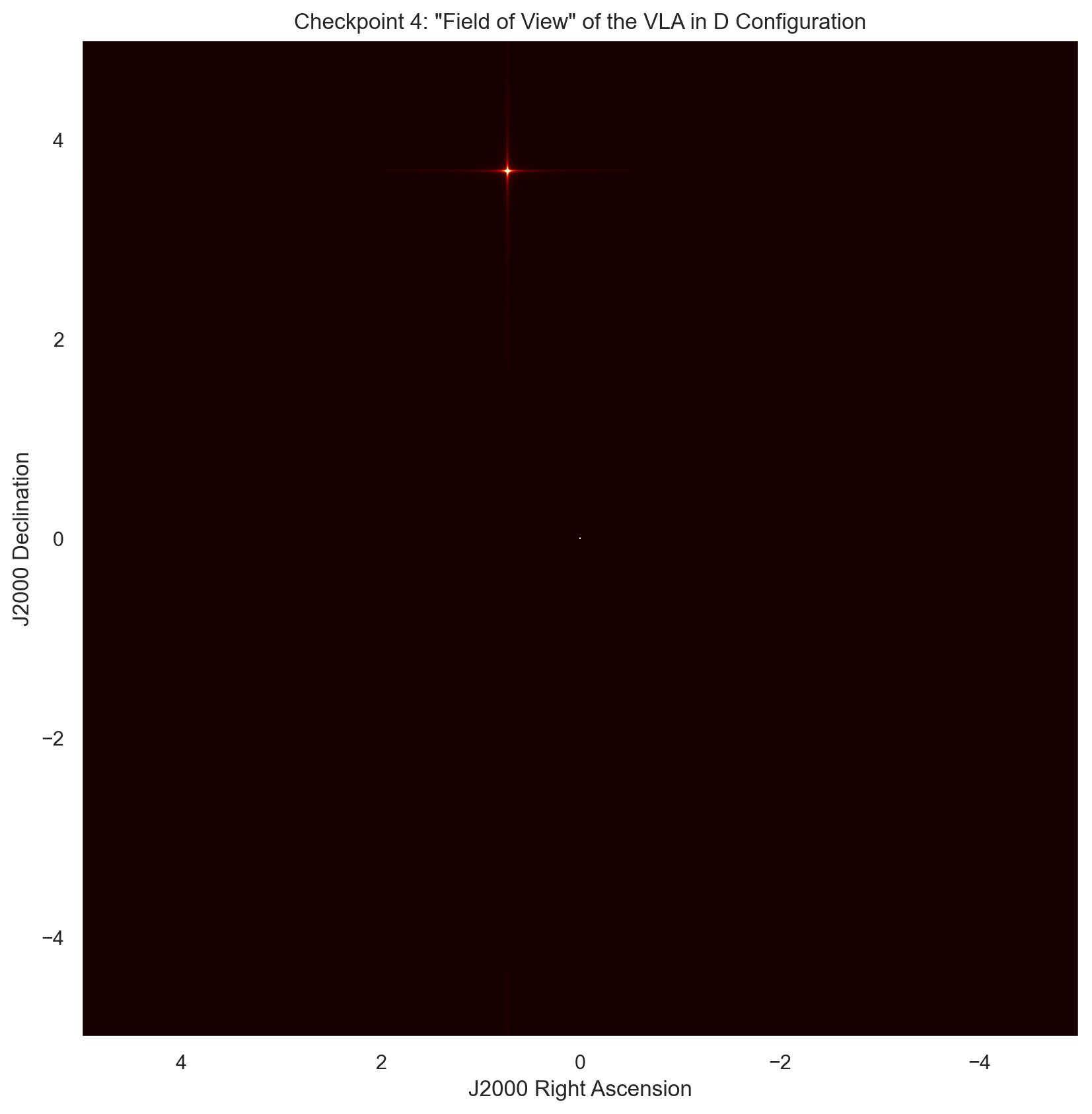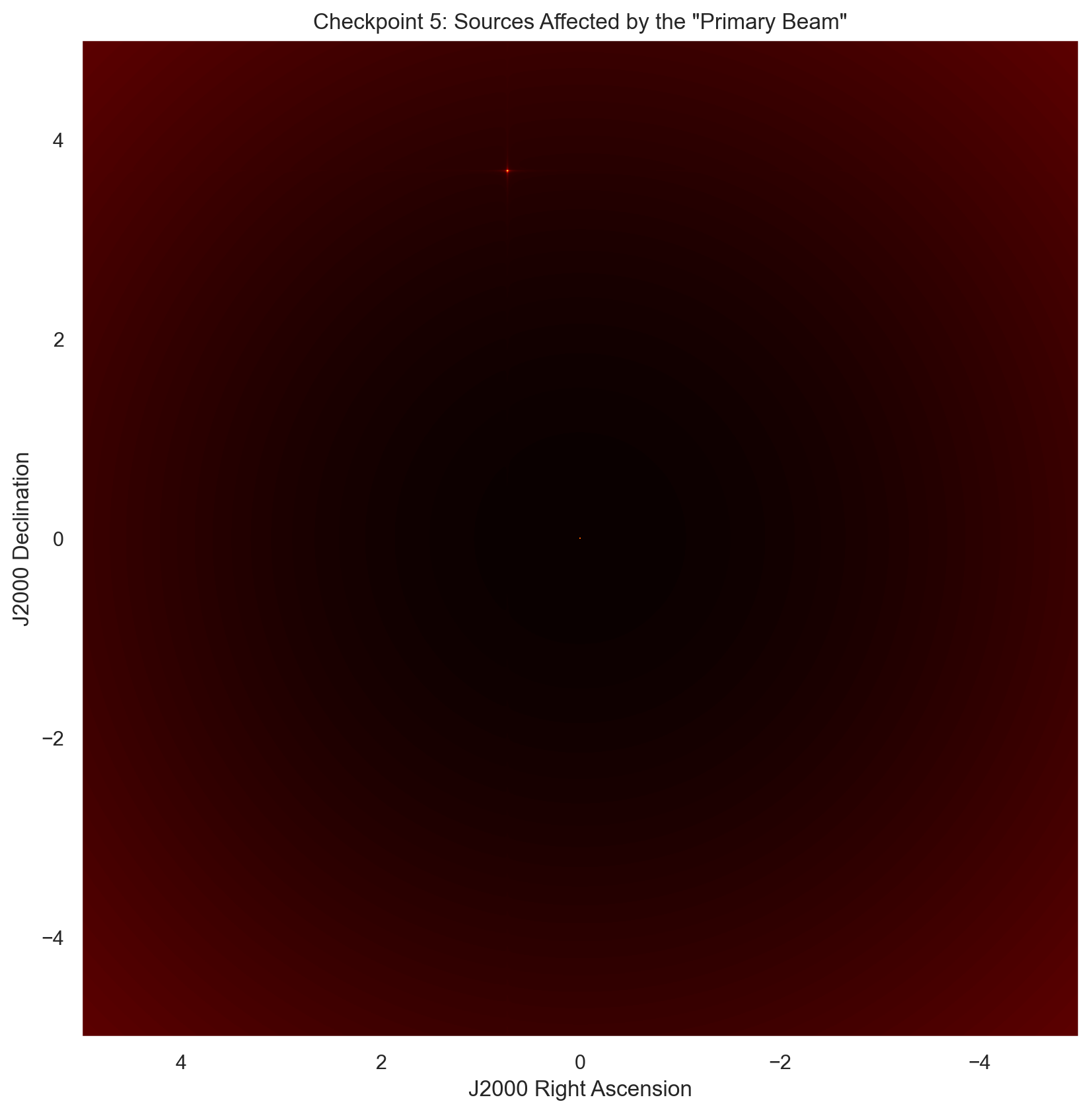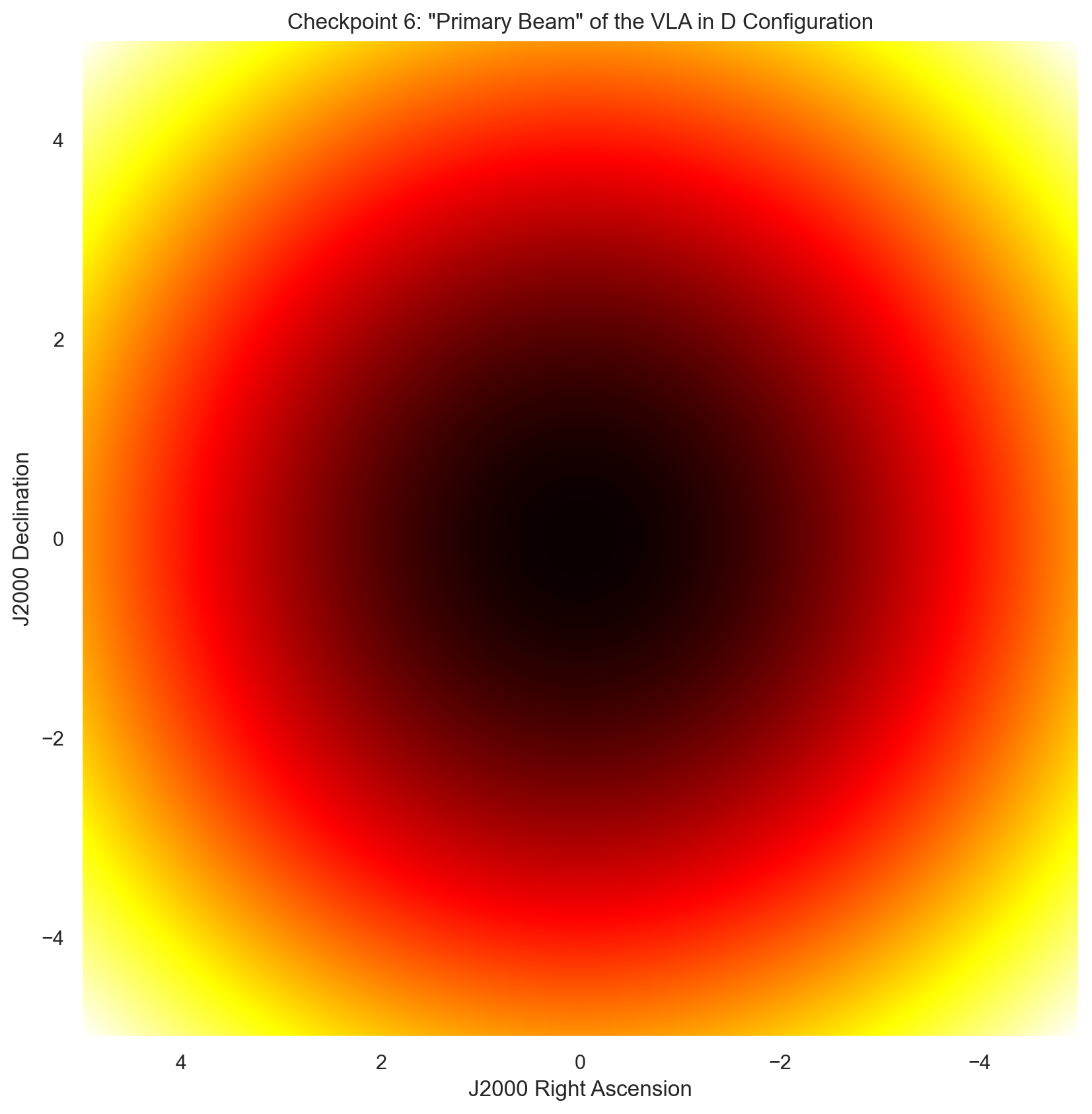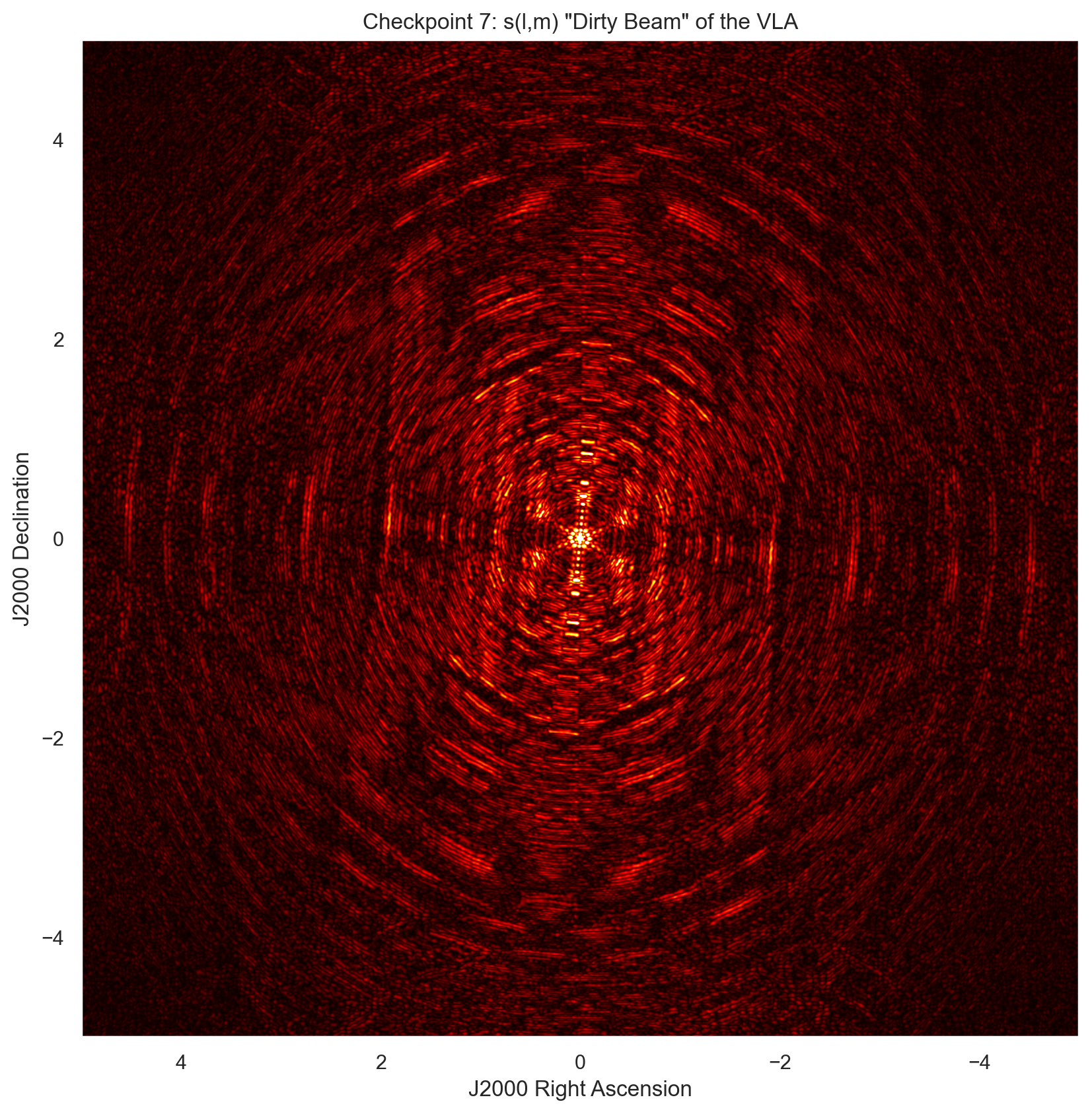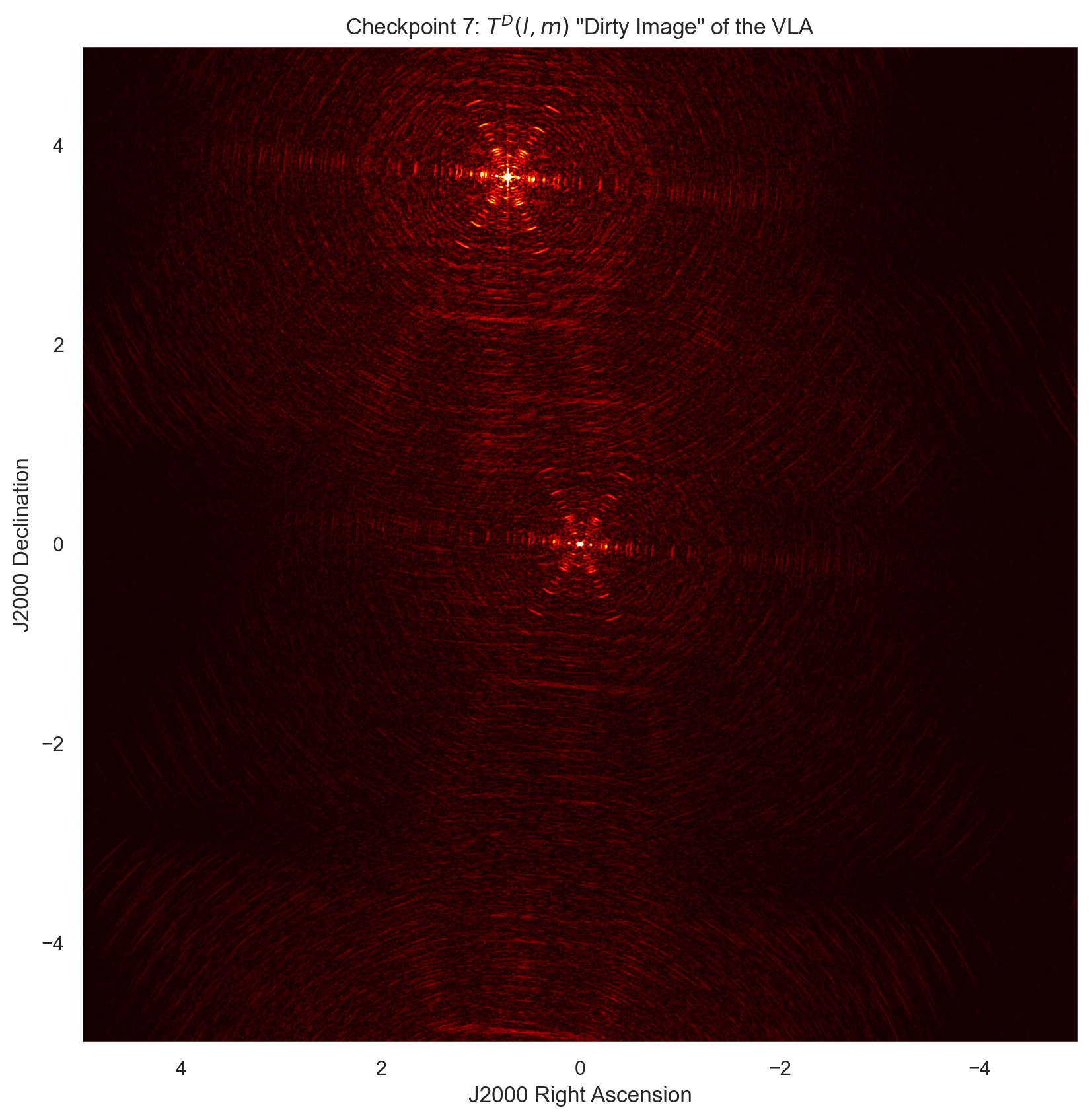Radio Interferometer Simulation
The VLA hosts 27 antennas, with each one comprising of a 25 meter dish housing 8 receivers with a weight of 209 metric tonnes. The dishes move across three arms of a track, on an altitude-azimuth mount, in the shape of a Y configuration. Using the specially designed lifting train (Heins Train), the array can extend and contract to four different configurations throughout the course of 16 months, allowing aperture synthesis interferometry of up to $ 351 $ baselines. At its maximum, the extension is akin to the optical zoom on a camera, able to resolve detail across further distance. In this configuration, the VLA lengthens each of its legs from two-thirds of a mile to 23 miles long. Configuration A is the largest, and for this project we will be working with the smallest of the list, configuration D.
Definitions
The first step is to import the data for the EVLA in D-Config. The $ x $ and $ y $ coordinates are cycled through to find all unique basline pairs possible. In this case, the VLA has 27 stations which corresponds directly to $ 351 $ baselines. The general formula for this relationship is $ \frac{1}{2}N(N-1) $.
Baseline Visibility: $ V(X,Y) $
The baseline station coordinates $ V(X,Y) $ are given by the unique differences, where $ xyz $ in the following represents the difference in $ x $, $ y $ and $ z $ respectively.
\[\begin{equation} V\left(X,Y\right)_{m,n} \forall m>n = \begin{pmatrix} 0 & 0 & 0 & 0 \\ xyz_{2,1} & 0 & 0 & 0 \\ xyz_{3,1} & xyz_{3,2} & 0 & 0 \\ xyz_{m,1} & xyz_{m,2} & xyz_{m,3} & 0 \end{pmatrix} \end{equation}\]$ V(X,Y) $ then represents a $ 351 \times 3 $ array containing unique cyclic pairs of the baseline coordinate differences ($ X $,$ Y $ and $ Z $) derived from the differences of the antenna coordinates $ x $, $ y $ and $ z $.
UV Visibility: $ V(X,Y) \to V(u,v) $
The transformation to uv coordinates $ V(u,v) $ is given by:
\[\begin{equation} \begin{pmatrix} u\\ v\\ w \end{pmatrix} = \frac{1}{\lambda} \begin{pmatrix} \sin H & \cos H & 0\\ -\sin \delta \cos H & \sin\delta\sin H & \cos\delta\\ \cos \delta \cos H & -\cos\delta\sin H & \sin\delta\\ \end{pmatrix} \begin{pmatrix} X\\ Y\\ Z \end{pmatrix}. \end{equation}\]Sampled Grid: $ S(u,v) \to s(l,m) $
Plotting the UV Visibilities over the hour angle $ H $ will give the UV Coverage $ V(u,v) $ over the course of earths rotation. To create the Dirty Beam $ s(l,m) $ we then need to map this function to a Sampled Grid, $ S(u,v) $. This is achieved via a Fourier transform. The completely filled in visibility plane is obtained via:
\[\begin{aligned} S(u,v) \to s(l,m) &= \mathcal{F}\left(\sum_k A_k \delta(l-l_k,m-m_k)\right) \\ &= \sum_k A_k e^{-2\pi i (ul_i+vm_i)} \end{aligned}\]True Image: $ T(l,m) $
The 2D Fourier transform, where $ T(l,m) $ is the True Image, is
\[\begin{equation} T(l,m) = \int_{-\infty}^{\infty} \int_{-\infty}^{\infty} V(u,v) e^{2\pi i(ul+vm)} \,du\,dv. \end{equation}\]With Euler’s formula $ e^{ix} = \cos x + i \sin x $ we can expand this to, in discrete form
\[\begin{aligned} T(l,m) = \sum_{u=-\infty}^{\infty} \sum_{v=-\infty}^{\infty} V(u,v) (\cos(2\pi(ul+vm)) + &\cdots \\ \cdots + i\sin(2\pi(ul+vm))) \,\Delta u\,\Delta &v, \end{aligned}\]and conversely the visibilities can be described as the sine/cosine decomposition of the image
\[\begin{aligned} V(u,v) = \sum_{l=-1}^{1} \sum_{m=-1}^{1} T(l,m) (\cos(2\pi(ul+vm)) - &\cdots \\ \cdots - i\sin(2\pi(ul+vm))) \,\Delta l\,\Delta &m. \end{aligned}\]Convolution Theorem: $ s(l,m)*T(l,m) = T^{D}(l,m) $
The Dirty Beam $ s(l,m) $ is then convoluted with the True Image $ T(l,m) $ to create the Dirty Image $ T^{D}(l,m) $
Primary Beam Width
The main beam full-width at half maximum (FWHM) beam width $ \theta_{PB} $ defines the region on the sky over which the bandwidth smearing occurs. We define the Aperture Efficiency as $ \eta \simeq\tfrac{1}{\sqrt{\ln{2}}} $, where the Primary Beam becomes
\[\begin{equation} \theta_{PB} = \frac{(180\times 3600)}{\pi}\frac{\eta\lambda}{D} \text{arcsec}. \end{equation}\]Synthesized Beam Width
The Synthesized Beam can be described in terms of the maximum baseline of the observation.
\[\begin{equation} \theta_{SB} \simeq \frac{(180\times 3600)}{\pi}\frac{\eta\lambda}{B_{max}} \text{arcsec} \end{equation}\]Fringe Period
For a source at beam half power, $ \theta = \tfrac{\lambda}{D} $. At that radius
\[\begin{equation} t = \frac{D}{B_{max}\omega_{E}} \end{equation}\]where $ \omega_{E} = 7.5\times 10^{-5} $rads$ ^{-1} $.
| Variable | Name |
|---|---|
| $ \eta $ | Illumination Taper Factor (Aperture Efficiency) |
| $ B_{max} $ | Maximum Baseline Difference |
| $ D $ | Antenna Diameter |
| $ \lambda $ | Observation Wavelength |
| $ \omega_{E} $ | Source Rotation Rate in the Sky |
Global Variables and Functions
import os
import numpy as np
%matplotlib inline
%config InlineBackend.figure_format ='retina'
import seaborn as sns; #sns.set()
sns.set_style("darkgrid", {'axes.grid' : False})
from matplotlib import pyplot as plt
from scipy import signal
#============================================================================#
# Global Variables and Functions #
#============================================================================#
os.makedirs('plots', exist_ok = True)
plt.rcParams['figure.dpi'] = 100
plt.rcParams.update({'font.size': 12})
#~~~~~~~~~~~~~~~~~~~~~~~~~~~~~~~~~~~~~~~~~~~~~~~~~~~~~~~~~~~~~~~~~~~~~~~~~~~~#
# Variable
f = 5e9 # Frequency 5GHz
HA = 1 # Hour Angle
DEC = np.radians(45) # Declination of source
noise = 0 # Noise of uv Sample Grid
#~~~~~~~~~~~~~~~~~~~~~~~~~~~~~~~~~~~~~~~~~~~~~~~~~~~~~~~~~~~~~~~~~~~~~~~~~~~~#
# Fixed
c = 3e8 # Speed of light
lam = c/f # Wavelength
steps = HA*120 # Samples every 30 seconds
H = np.linspace(-0.5*HA, 0.5*HA, steps)*(np.pi/12) # Celestial Hour Angle
D = 25 # Diameter of Antenna in meters
taper_factor = (np.sqrt(np.log(2)))**(-1) # Illumination Taper Factor
prim_beam_width = ((180*3600)/np.pi)*(taper_factor*lam/D) # Primary Beam Width
pixels = int(prim_beam_width*1.685) # Pixel count for image
rescale = int(0.337*prim_beam_width) # Pixel rescale for grid
#~~~~~~~~~~~~~~~~~~~~~~~~~~~~~~~~~~~~~~~~~~~~~~~~~~~~~~~~~~~~~~~~~~~~~~~~~~~~#
# Gaussian Kernel
def gkern(n, std = 1, norm = False):
'''
Generates a n x n matrix with a centered gaussian
of standard deviation std centered on it. If normalised,
its volume equals 1.'''
gaussian1D = signal.gaussian(n, std)
gaussian2D = np.outer(gaussian1D, gaussian1D)
if norm:
gaussian2D /= (2*np.pi*(std**2))
return gaussian2D
def point_sources(file):
''' Point source data read in following format:
--------------------------------------------------------------
Right Ascension | Declination | Flux | Flux Labels
--------------------------------------------------------------
'''
data_ps = np.loadtxt(file, dtype = float, usecols = (0,1,2))
RA_ps, DEC_ps, flux_ps = data_ps[:,0]*(np.pi/12), \
data_ps[:,1]*(np.pi/180), data_ps[:,2]
RA_diff = RA_ps - RA_ps[0]
# Conversion into T(l,m)
l = np.cos(DEC_ps)*np.sin(RA_diff)
m = (np.sin(DEC_ps)*np.cos(DEC_ps[0]) -
np.cos(DEC_ps)*np.sin(DEC_ps[0])*np.cos(RA_diff))
''' Point source data output in following format:
--------------------------------------------------------------
Flux | l | m
--------------------------------------------------------------
'''
#~~~~~~~~~~~~~~~~~~~~~~~~~~~~~~~~~~~~~~~~~~~~~~~~~~~~~~~~~~~~~~~~~~~~~~~~#
# Point sources
ps = np.zeros((len(data_ps), 3))
ps[:,0] = flux_ps
# l, m in degrees
ps[:,1] = l[0:]*(180/np.pi)
ps[:,2] = m[0:]*(180/np.pi)
#~~~~~~~~~~~~~~~~~~~~~~~~~~~~~~~~~~~~~~~~~~~~~~~~~~~~~~~~~~~~~~~~~~~~~~~~#
# Visibility tracks
u_vis, v_vis = np.zeros((steps, len(DEC_ps))), \
np.zeros((steps, len(DEC_ps)))
for i in range(len(DEC_ps)):
u_vis[:, i] = lam**(-1)*np.cos(H)
v_vis[:, i] = lam**(-1)*np.sin(H)*np.sin(DEC_ps[i])
return l, m, u_vis, v_vis
#============================================================================#
# Mathsy Stuff #
#============================================================================#
# For loading EVLA in D-Config
def import_file_VLA(file):
'''
Import data, first column as str, others as float
File must be of the following format:
--------------------------------------------------------------
station | L_x | L_y | L_z | R |
--------------------------------------------------------------
import_file handles all the importing of data, and performing math
operations to pass to plotting functions.
'''
name = np.loadtxt(file, dtype = str, usecols = 0, skiprows = 1) # Stations
xyz = np.loadtxt(file, usecols = (1,2,3), skiprows = 1) # Positions
l, m, u_vis, v_vis = point_sources('data/point_sources.txt')
b = int(0.5*(len(xyz)*(len(xyz) - 1))) # Number of baselines
#~~~~~~~~~~~~~~~~~~~~~~~~~~~~~~~~~~~~~~~~~~~~~~~~~~~~~~~~~~~~~~~~~~~~~~~~#
# Difference between station arrays - 351 baselines for EVLA: 27 stations
XYZ = [] # X, Y, Z Coordinate differences of x, y, z
for i, xyz_1 in enumerate(xyz):
for j, xyz_2 in enumerate(xyz):
if i < j:
XYZ.append(xyz_1 - xyz_2) # Differences in x, y and z
XYZ = np.array(XYZ)
b_max = np.amax(XYZ[:,0:1]) - np.abs(np.amin(XYZ[:,0:1]))
fringe_sep = lam/b_max
synth_beam_width = ((180*3600)/np.pi)*(taper_factor*lam/b_max)
fringe_period = (7.3e-5)**(-1)*D/b_max
#~~~~~~~~~~~~~~~~~~~~~~~~~~~~~~~~~~~~~~~~~~~~~~~~~~~~~~~~~~~~~~~~~~~~~~~~#
# Transform to UV coordinates: V(u,v), cycle across hour angle
X, Y, Z = XYZ[:,0], XYZ[:,1], XYZ[:,2]
u, v, w = np.zeros((b, steps)), np.zeros((b, steps)), np.zeros((b, steps))
for i in range(b):
u[i, :] = lam**(-1)*(np.sin(H)*X[i] + np.cos(H)*Y[i])
v[i, :] = lam**(-1)*(-np.sin(DEC)*np.cos(H)*X[i] +
np.sin(DEC)*np.sin(H)*Y[i] +
np.cos(DEC)*Z[i])
# w[i, :] = lam**(-1)*(np.cos(DEC)*np.cos(H)*X[i] - # Unused
# np.cos(DEC)*np.sin(H)*Y[i] +
# np.sin(DEC)*Z[i])
#~~~~~~~~~~~~~~~~~~~~~~~~~~~~~~~~~~~~~~~~~~~~~~~~~~~~~~~~~~~~~~~~~~~~~~~~#
# Create the dimensions of the observed visibility plane
u_vismax, v_vismax = np.amax(np.abs(u_vis)), np.amax(np.abs(v_vis))
u_visgrid = np.linspace(-u_vismax, u_vismax, steps)
v_visgrid = np.linspace(-v_vismax, v_vismax, steps)
U, V = np.meshgrid(u_visgrid, v_visgrid)
obs = np.zeros(U.shape).astype(complex)
# Cycle through point source values to create True Image: T(l,m)
for i in ps:
F, l, m = i
obs += F*np.exp(2*np.pi*1j*(U*l + V*m))
obs += F*np.exp(2*np.pi*1j*(u_vis[:, 0]*l + v_vis[:, 0]*m))
obs += F*np.exp(2*np.pi*1j*(u_vis[:, 1]*l + v_vis[:, 1]*m))
#~~~~~~~~~~~~~~~~~~~~~~~~~~~~~~~~~~~~~~~~~~~~~~~~~~~~~~~~~~~~~~~~~~~~~~~~#
# Create the dimensions of the full visibility plane
u_max, v_max = np.amax(np.abs(u)), np.amax(np.abs(v))
ugrid = np.linspace(-u_max, u_max, pixels)
vgrid = np.linspace(-v_max, v_max, pixels)
uu, vv = np.meshgrid(ugrid, vgrid)
image = np.zeros(uu.shape).astype(complex)
# Cycle through point source values to create True Image: T(l,m)
for i in ps:
F, l, m = i
image += F*np.exp(2*np.pi*1j*(uu*l + vv*m)) # True Image T(l,m)
#~~~~~~~~~~~~~~~~~~~~~~~~~~~~~~~~~~~~~~~~~~~~~~~~~~~~~~~~~~~~~~~~~~~~~~~~#
# Create the sample grid: S(u,v), Creates Dirty Beam when fft: s(l,m)
uv_grid = np.random.normal(0, noise, (pixels, pixels))#.astype(complex)
# Sample the Visibility grid: V(u,v)*S(u,v)
for i in range(steps):
try:
uv_grid[(v[:,i]/rescale).astype(np.int),
(u[:,i]/rescale).astype(np.int)] = 1
uv_grid[(-v[:,i]/rescale).astype(np.int),
(-u[:,i]/rescale).astype(np.int)] = 1
except Exception:
# If uv sample is > pixels, skip.
pass
# FFT the sampled visibilty grid: fft{V(u,v)*S(u,v)} = s(l,m)
dirty_beam = np.abs(np.fft.fftshift(np.fft.fft2(uv_grid)))
#~~~~~~~~~~~~~~~~~~~~~~~~~~~~~~~~~~~~~~~~~~~~~~~~~~~~~~~~~~~~~~~~~~~~~~~~#
# True Image Convolved with Sampled Grid = Dirty Image
# s(l,m)*T(l,m) = T^D(l,m)
dirty_image = np.abs(np.fft.fftshift(np.fft.ifft2(dirty_beam*image)))
#~~~~~~~~~~~~~~~~~~~~~~~~~~~~~~~~~~~~~~~~~~~~~~~~~~~~~~~~~~~~~~~~~~~~~~~~#
# Orient images on the sky correctly
image = np.rot90(image,3) # True Image T(l,m)
dirty_beam = np.rot90(dirty_beam,3) # Dirty Beam s(l,m)
uv_grid = np.rot90(uv_grid,3) # Sample UV Grid S(u,v)
dirty_image = np.rot90(dirty_image,3) # Dirty Image T^D(l,m)
return name, xyz, b_max, XYZ, synth_beam_width, fringe_sep, obs, \
fringe_period, u, v, image, uv_grid, dirty_beam, dirty_image
| Variable | Name |
|---|---|
| $ xyz $ | Station Coordinates |
| $ XYZ $ | Baseline Coordinate Differences: $V(X,Y)$ |
| $ uvw $ | UV Coordinates $ V(u,v)$ |
| $ DEC $ | Declination |
| $ H$ | Hour Angle Sample Array |
| $ T$ | True Image: $T(u,v)$ |
| $ S$ | Sample Grid: $S(u,v)$ |
| $s$ | Fourier Transformed Sample Grid: $s(l,m)$ |
| $sT$ | True Image Convolved with Sample Grid: $T^{D}(l,m)$ |
def main(file):
name, xyz, b_max, XYZ, synth_beam_width, fringe_sep, obs, fringe_period, \
u, v, image, uv_grid, dirty_beam, dirty_image = import_file_VLA(file)
#========================================================================#
# Checkpoint 1 #
#========================================================================#
# Plot the station locations
fig, ax = plt.subplots(figsize = (25, 24))
plt.subplot(331)
plt.plot(xyz[:,1], xyz[:,2], 'or')
plt.xlabel('x [ns]')
plt.ylabel('y [ns]')
plt.title('Checkpoint 1: VLA in D Configuration')
for i, txt in enumerate(name): # Add station names to locations
plt.annotate(txt, (xyz[:,1][i], xyz[:,2][i]))
#========================================================================#
# Checkpoint 2 #
#========================================================================#
# Snapshot UV-Coverage
plt.subplot(332)
snapshot = int(steps/2)
plt.plot(u[:,snapshot]/1e3, v[:,snapshot]/1e3, 'ob', ms = 1)
plt.plot(-u[:,snapshot]/1e3, -v[:,snapshot]/1e3, 'o', color = 'tab:red',
ms = 1, alpha = 0.9)
plt.title('Checkpoint 2: Snapshot UV Coverage of VLA in D Configuration')
plt.xlabel('u [$\mu$sm$^{-1}$]')
plt.ylabel('v [$\mu$sm$^{-1}$]')
# Plot the UV-Coverage
plt.subplot(333)
plt.plot(u/1e3, v/1e3, 'o', color = 'b', ms = 1, alpha = 0.05)
plt.plot(-u/1e3, -v/1e3, 'o', color = 'tab:red', ms = 1, alpha = 0.05)
plt.title('Checkpoint 2: UV Coverage of VLA in D '+
'Configuration, %i HA' %HA)
plt.xlabel('u [$\mu$sm$^{-1}$]')
plt.ylabel('v [$\mu$sm$^{-1}$]')
#========================================================================#
# Checkpoint 3 #
#========================================================================#
print('Checkpoint 3: The Fringe Period is',fringe_period,'seconds.')
#========================================================================#
# Checkpoint 4 #
#========================================================================#
# Plot the True Image T(l,m)
plt.subplot(334)
#plt.axis('off')
plt.title('Checkpoint 4: \"Field of View\" of the VLA in D Configuration')
plt.xlabel("J2000 Right Ascension")
plt.ylabel("J2000 Declination")
fov = np.abs(np.fft.fftshift(np.fft.ifft2(image)))
plt.imshow(fov, cmap = 'hot', aspect = 'equal',
vmin = -0.01, vmax = 0.5, extent = [5, -5, -5, 5])
#========================================================================#
# Checkpoint 5 #
#========================================================================#
# Reduction in peak response due to bandwidth smearing
plt.subplot(335)
plt.title('Checkpoint 5: Sources Affected by the \"Primary Beam\"')
plt.xlabel("J2000 Right Ascension")
plt.ylabel("J2000 Declination")
primary_beam = gkern(pixels, prim_beam_width, norm = False)
peak_loss = fov - primary_beam
plt.imshow(peak_loss, cmap = 'hot', aspect = 'equal',
extent = [5, -5, -5, 5])
sig_loss = np.amax(fov) - np.amax(peak_loss)
print('Checkpoint 5: Origin point source signal is',
'unnaffected by a reduction in peak response.')
print('Checkpoint 5: Offset point source reduction in',
'peak response from the primary beam is:',sig_loss)
#========================================================================#
# Checkpoint 6 #
#========================================================================#
# Plot the primary beam.
plt.subplot(336)
plt.xlabel("J2000 Right Ascension")
plt.ylabel("J2000 Declination")
plt.title('Checkpoint 6: \"Primary Beam\" of the VLA in D Configuration')
primary_beam = gkern(pixels, std = prim_beam_width, norm = False)
plt.imshow(-primary_beam, cmap = 'hot', aspect = 'equal',
extent = [5, -5, -5, 5])
print('Checkpoint 6: The Primary Beam-Width is',prim_beam_width,'arcsec.')
#========================================================================#
# Checkpoint 7 #
#========================================================================#
# Plot the Dirty Beam s(l,m)
plt.subplot(337)
plt.imshow(dirty_beam, cmap = 'hot', vmin = -0.1, vmax = 1000,
extent = [5, -5, -5, 5],
interpolation = 'gaussian')
plt.title('Checkpoint 7: s(l,m) \"Dirty Beam\" of the VLA')
plt.xlabel("J2000 Right Ascension")
plt.ylabel("J2000 Declination")
print('Checkpoint 7: The Synthesized Beam-Width is',
synth_beam_width,'arcsec.')
#~~~~~~~~~~~~~~~~~~~~~~~~~~~~~~~~~~~~~~~~~~~~~~~~~~~~~~~~~~~~~~~~~~~~~~~~#
# Plot the Dirty Image s(l,m)*T(l,m)
plt.subplot(338)
plt.imshow(dirty_image, cmap = 'hot', vmin = -0.1, vmax = 10,
extent = [5, -5, -5, 5],
interpolation = 'gaussian')
plt.title('Checkpoint 7: $T^{D}(l,m)$ \"Dirty Image\" of the VLA')
plt.xlabel("J2000 Right Ascension")
plt.ylabel("J2000 Declination")
#~~~~~~~~~~~~~~~~~~~~~~~~~~~~~~~~~~~~~~~~~~~~~~~~~~~~~~~~~~~~~~~~~~~~~~~~#
# Hogbom Method
I0 = 0
I1 = dirty_image - dirty_beam*I0
I2 = dirty_image - dirty_beam*I1
CLEAN = I2*dirty_beam + (dirty_image - dirty_beam*I2)
plt.subplot(339)
plt.imshow(CLEAN, cmap = 'hot', vmin = 0, vmax = 1000,
extent = [5, -5, -5, 5],
interpolation = 'gaussian')
plt.title('Checkpoint 7: Hogbom CLEAN, 2 iter')
plt.xlabel("J2000 Right Ascension")
plt.ylabel("J2000 Declination")
fig.tight_layout()
plt.savefig('plots/Checkpoints.png')
main('data/vla_d.txt')
Checkpoint 3: The Fringe Period is 327.8188090368893 seconds.
Checkpoint 5: Origin point source signal is unnaffected by a reduction in peak response.
Checkpoint 5: Offset point source reduction in peak response from the primary beam is: 0.8186483660039867
Checkpoint 6: The Primary Beam-Width is 594.5982742257186 arcsec.
Checkpoint 7: The Synthesized Beam-Width is 14.22919636218073 arcsec.
def main(file):
name, xyz, b_max, XYZ, synth_beam_width, fringe_sep, obs, fringe_period, \
u, v, image, uv_grid, dirty_beam, dirty_image = import_file_VLA(file)
#========================================================================#
# Checkpoint 1 #
#========================================================================#
# Plot the station locations
fig, ax = plt.subplots(figsize = (10, 10))
plt.plot(xyz[:,1], xyz[:,2], 'or')
plt.xlabel('x [ns]')
plt.ylabel('y [ns]')
plt.title('Checkpoint 1: VLA in D Configuration')
for i, txt in enumerate(name): # Add station names to locations
plt.annotate(txt, (xyz[:,1][i], xyz[:,2][i]))
#========================================================================#
# Checkpoint 2 #
#========================================================================#
# Snapshot UV-Coverage
fig, ax = plt.subplots(figsize = (10, 10))
snapshot = int(steps/2)
plt.plot(u[:,snapshot]/1e3, v[:,snapshot]/1e3, 'ob', ms = 1)
plt.plot(-u[:,snapshot]/1e3, -v[:,snapshot]/1e3, 'o', color = 'tab:red',
ms = 1, alpha = 0.9)
plt.title('Checkpoint 2: Snapshot UV Coverage of VLA in D Configuration')
plt.xlabel('u [$\mu$sm$^{-1}$]')
plt.ylabel('v [$\mu$sm$^{-1}$]')
# Plot the UV-Coverage
fig, ax = plt.subplots(figsize = (10, 10))
plt.plot(u/1e3, v/1e3, 'o', color = 'b', ms = 1, alpha = 0.05)
plt.plot(-u/1e3, -v/1e3, 'o', color = 'tab:red', ms = 1, alpha = 0.05)
plt.title('Checkpoint 2: UV Coverage of VLA in D '+
'Configuration, %i HA' %HA)
plt.xlabel('u [$\mu$sm$^{-1}$]')
plt.ylabel('v [$\mu$sm$^{-1}$]')
#========================================================================#
# Checkpoint 3 #
#========================================================================#
print('Checkpoint 3: The Fringe Period is',fringe_period,'seconds.')
#========================================================================#
# Checkpoint 4 #
#========================================================================#
# Plot the True Image T(l,m)
fig, ax = plt.subplots(figsize = (10, 10))
#plt.axis('off')
plt.title('Checkpoint 4: \"Field of View\" of the VLA in D Configuration')
plt.xlabel("J2000 Right Ascension")
plt.ylabel("J2000 Declination")
fov = np.abs(np.fft.fftshift(np.fft.ifft2(image)))
plt.imshow(fov, cmap = 'hot', aspect = 'equal',
vmin = -0.01, vmax = 0.5, extent = [5, -5, -5, 5])
#========================================================================#
# Checkpoint 5 #
#========================================================================#
# Reduction in peak response due to bandwidth smearing
fig, ax = plt.subplots(figsize = (10, 10))
plt.title('Checkpoint 5: Sources Affected by the \"Primary Beam\"')
plt.xlabel("J2000 Right Ascension")
plt.ylabel("J2000 Declination")
primary_beam = gkern(pixels, prim_beam_width, norm = False)
peak_loss = fov - primary_beam
plt.imshow(peak_loss, cmap = 'hot', aspect = 'equal',
extent = [5, -5, -5, 5])
sig_loss = np.amax(fov) - np.amax(peak_loss)
print('Checkpoint 5: Origin point source signal is',
'unnaffected by a reduction in peak response.')
print('Checkpoint 5: Offset point source reduction in',
'peak response from the primary beam is:',sig_loss)
#========================================================================#
# Checkpoint 6 #
#========================================================================#
# Plot the primary beam.
fig, ax = plt.subplots(figsize = (10, 10))
plt.xlabel("J2000 Right Ascension")
plt.ylabel("J2000 Declination")
plt.title('Checkpoint 6: \"Primary Beam\" of the VLA in D Configuration')
primary_beam = gkern(pixels, std = prim_beam_width, norm = False)
plt.imshow(-primary_beam, cmap = 'hot', aspect = 'equal',
extent = [5, -5, -5, 5])
print('Checkpoint 6: The Primary Beam-Width is',prim_beam_width,'arcsec.')
#========================================================================#
# Checkpoint 7 #
#========================================================================#
# Plot the Dirty Beam s(l,m)
fig, ax = plt.subplots(figsize = (10, 10))
plt.imshow(dirty_beam, cmap = 'hot', vmin = -0.1, vmax = 1000,
extent = [5, -5, -5, 5],
interpolation = 'gaussian')
plt.title('Checkpoint 7: s(l,m) \"Dirty Beam\" of the VLA')
plt.xlabel("J2000 Right Ascension")
plt.ylabel("J2000 Declination")
print('Checkpoint 7: The Synthesized Beam-Width is',
synth_beam_width,'arcsec.')
#~~~~~~~~~~~~~~~~~~~~~~~~~~~~~~~~~~~~~~~~~~~~~~~~~~~~~~~~~~~~~~~~~~~~~~~~#
# Plot the Dirty Image s(l,m)*T(l,m)
fig, ax = plt.subplots(figsize = (10, 10))
plt.imshow(dirty_image, cmap = 'hot', vmin = -0.1, vmax = 10,
extent = [5, -5, -5, 5],
interpolation = 'gaussian')
plt.title('Checkpoint 7: $T^{D}(l,m)$ \"Dirty Image\" of the VLA')
plt.xlabel("J2000 Right Ascension")
plt.ylabel("J2000 Declination")
#~~~~~~~~~~~~~~~~~~~~~~~~~~~~~~~~~~~~~~~~~~~~~~~~~~~~~~~~~~~~~~~~~~~~~~~~#
# Hogbom Method
#I0 = 0
#I1 = dirty_image - dirty_beam*I0
#I2 = dirty_image - dirty_beam*I1
#CLEAN = I2*dirty_beam + (dirty_image - dirty_beam*I2)
#fig, ax = plt.subplots(figsize = (10, 10))
#plt.imshow(CLEAN, cmap = 'hot', vmin = 0, vmax = 1000,
# extent = [5, -5, -5, 5],
# interpolation = 'gaussian')
#plt.title('Checkpoint 7: Hogbom CLEAN, 2 iter')
#plt.xlabel("J2000 Right Ascension")
#plt.ylabel("J2000 Declination")
#fig.tight_layout()
#plt.savefig('plots/Checkpoints.png')
main('data/vla_d.txt')
Checkpoint 3: The Fringe Period is 327.8188090368893 seconds.
Checkpoint 5: Origin point source signal is unnaffected by a reduction in peak response.
Checkpoint 5: Offset point source reduction in peak response from the primary beam is: 0.8186483660039867
Checkpoint 6: The Primary Beam-Width is 594.5982742257186 arcsec.
Checkpoint 7: The Synthesized Beam-Width is 14.22919636218073 arcsec.
Checkpoint 3
A diagram to show the real and imaginary components of your “observed” data [6].
#============================================================================#
# Checkpoint 3 #
#============================================================================#
# A diagram to show the real and imaginary components of your “observed” data.
# Real part
fig, ax = plt.subplots(figsize = (10,10))
plt.subplot(211)
plt.imshow(obs.real, extent = [-1*(np.amax(abs(u_vis))) - 10,
np.amax(abs(u_vis)) + 10,
-1*(np.amax(abs(v_vis))) - 10,
np.amax(abs(v_vis)) + 10],
cmap = 'hot')
plt.plot(u_vis[:, 0], v_vis[:, 0],"k", lw = 0.5)
plt.plot(-u_vis[:, 1], -v_vis[:, 1],"k", lw = 0.5)
plt.xlabel("u")
plt.ylabel("v")
if HA > 1:
plt.title("Checkpoint 3: Real Component of Observed Data (%i Hours)" %HA)
else:
plt.title("Checkpoint 3: Real Component of Observed Data (%i Hour)" %HA)
plt.colorbar(shrink=0.75)
# Imag part
plt.subplot(212)
plt.imshow(obs.imag, extent = [-1*(np.amax(abs(u_vis))) - 10,
np.amax(abs(u_vis)) + 10,
-1*(np.amax(abs(v_vis))) - 10,
np.amax(abs(v_vis)) + 10],
cmap = 'hot')
plt.plot(u_vis[:, 0], v_vis[:, 0],"k", lw = 0.5)
plt.plot(-u_vis[:, 1], -v_vis[:, 1],"k", lw = 0.5)
plt.xlabel("u")
plt.ylabel("v")
if HA > 1:
plt.title("Checkpoint 3: Imaginary Component of Observed Data (%i Hours)" %HA)
else:
plt.title("Checkpoint 3: Imaginary Component of Observed Data (%i Hour)" %HA)
plt.colorbar(shrink=0.75)
<matplotlib.colorbar.Colorbar at 0x177916bc8e0>
Appendix
A: Test Plots
fig, ax = plt.subplots(figsize = (15,15))
plt.subplot(131)
plt.axis('off')
#plt.title('Sample UV Grid S(u,v) Before Convolution')
plt.imshow(np.fft.fftshift(uv_grid), cmap = 'hot', aspect = 'equal', vmin = 0, vmax = 0.5)
plt.subplot(132)
plt.axis('off')
#plt.title('Sample UV Grid s(l,m) Before Convolution')
sTa = np.abs(np.fft.fftshift(np.fft.ifft2(dirty_beam)))
plt.imshow(sTa, cmap = 'hot', aspect = 'equal', vmin = -0.1, vmax = 1)
plt.subplot(133)
plt.axis('off')
#plt.title('Sample UV Grid s(l,m)*T(l,m) After Convolution')
sTa = np.abs(np.fft.fftshift(np.fft.ifft2(uv_grid)))
plt.imshow(sTa, cmap = 'hot', aspect = 'equal')
fig.tight_layout()
fig, ax = plt.subplots(figsize = (15,15))
plt.axis('off')
plt.imshow(image.imag, cmap = 'hot', aspect = 'equal', extent = [-1,1,-1,1])
fig, ax = plt.subplots(figsize = (15,15))
plt.axis('off')
plt.imshow(image.real, cmap = 'hot', aspect = 'equal')
B: Comparison with SKA
#============================================================================#
# Extra Testing with SKA data
#============================================================================#
def import_file_SKA(file):
xyz = np.loadtxt(file, dtype = float, usecols = (0,1,2), delimiter = ',')
b = int(0.5*len(xyz)*(len(xyz)-1))
XYZ = []
for i, xyz_1 in enumerate(xyz):
for j, xyz_2 in enumerate(xyz):
if i < j:
XYZ.append(xyz_1 - xyz_2)
XYZ = np.array(XYZ)
b_max = np.amax(XYZ[:,0:1]) - np.abs(np.amin(XYZ[:,0:1]))
synth_beam_width = ((180*3600)/np.pi)*(taper_factor*lam/b_max)
#~~~~~~~~~~~~~~~~~~~~~~~~~~~~~~~~~~~~~~~~~~~~~~~~~~~~~~~~~~~~~~~~~~~~~~~~#
# Transform to UV coordinates: V(u,v), cycle across hour angle
X, Y, Z = XYZ[:,0], XYZ[:,1], XYZ[:,2]
u, v, w = np.zeros((b, steps)), np.zeros((b, steps)), np.zeros((b, steps))
for i in range(b):
u[i, :] = lam**(-1)*(np.sin(H)*X[i] + np.cos(H)*Y[i])
v[i, :] = lam**(-1)*(-np.sin(DEC)*np.cos(H)*X[i] +
np.sin(DEC)*np.sin(H)*Y[i] +
np.cos(DEC)*Z[i])
#~~~~~~~~~~~~~~~~~~~~~~~~~~~~~~~~~~~~~~~~~~~~~~~~~~~~~~~~~~~~~~~~~~~~~~~~#
# Create the sample grid: S(u,v), Creates Dirty Beam when fft = s(l,m)
uv_grid = np.random.normal(0, noise, (pixels, pixels))
for i in range(steps):
uv_grid[(v[:,i]/1e4).astype(np.int), (u[:,i]/1e4).astype(np.int)] = 1
uv_grid[(-v[:,i]/1e4).astype(np.int), (-u[:,i]/1e4).astype(np.int)] = 1
dirty_beam = np.abs(np.fft.fftshift(np.fft.fft2(uv_grid)))
dirty_beam = np.rot90(dirty_beam,3) # Dirty Beam s(l,m)
return xyz, u, v, synth_beam_width, dirty_beam
def multi_plot(file, title):
if title == 'VLA D':
name, xyz, b_max, XYZ, synth_beam_width, fringe_sep, fringe_period, \
obs, u, v, image, uv_grid, dirty_beam, dirty_image = import_file_VLA(file)
else:
xyz, u, v, synth_beam_width, dirty_beam = import_file_SKA(file)
fig, ax = plt.subplots(figsize = (15,5))
# Plot Layout
plt.subplot(131)
plt.plot(xyz[:,1], xyz[:,2], 'o', ms = 1)
plt.xlabel('x [ns]')
plt.ylabel('y [ns]')
plt.axis('off')
plt.title(title+' Configuration')
# Plot the UV-Coverage
plt.subplot(132)
plt.title(title+' UV Coverage')
plt.plot(u/1e3, v/1e3, 'or', ms = 1, alpha = 0.01)
plt.plot(-u/1e3, -v/1e3, 'ob', ms = 1, alpha = 0.01) # Conjugates
plt.axis('off')
# Plot Dirty Beam
plt.subplot(133)
plt.title(title+' Dirty Beam')
plt.axis('off')
plt.imshow(dirty_beam, cmap = 'hot', vmin = -0.1, vmax = 1500,
interpolation = 'gaussian')
print('The Synthesized Beam-Width is',synth_beam_width,'arcsec.')
fig.tight_layout()
DEC = np.radians(45)
multi_plot('data/vla_d.txt', 'VLA D')
DEC = np.radians(-30)
multi_plot('data/SKA1_mid_ecef.txt', 'SKA Mid ECEF')
The Synthesized Beam-Width is 14.22919636218073 arcsec.
The Synthesized Beam-Width is 0.3660676730362001 arcsec.



